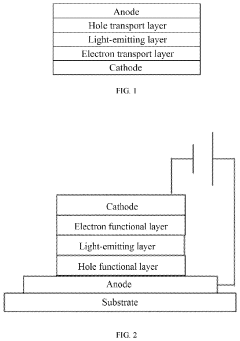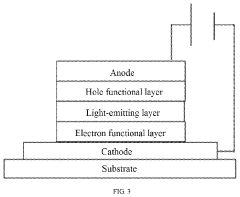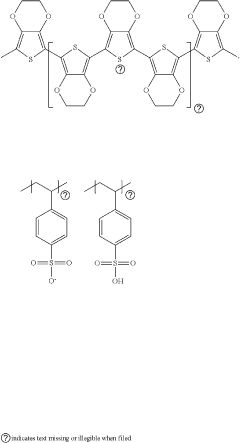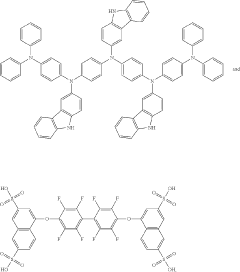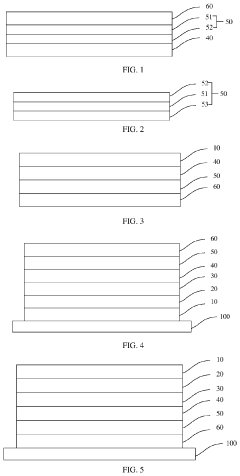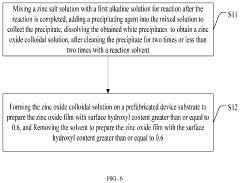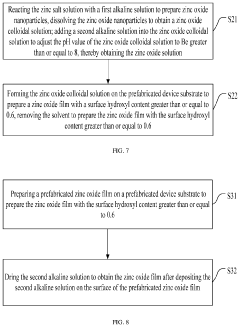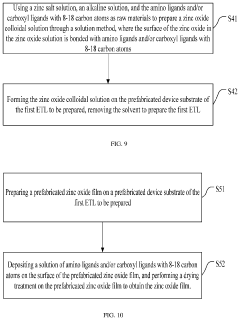QLED Revolutionizes Retail Display Experiences
JUN 19, 202510 MIN READ
Generate Your Research Report Instantly with AI Agent
Patsnap Eureka helps you evaluate technical feasibility & market potential.
QLED Technology Evolution and Objectives
QLED (Quantum Dot Light-Emitting Diode) technology has emerged as a revolutionary force in the display industry, particularly in the retail sector. This cutting-edge technology has its roots in the broader field of quantum dot research, which began in the 1980s. The evolution of QLED technology has been marked by significant milestones, leading to its current status as a game-changer in retail display experiences.
The journey of QLED technology started with the discovery of quantum dots' unique light-emitting properties. These nanoscale semiconductor particles exhibit size-dependent optical and electronic properties, allowing for precise control over the color and intensity of emitted light. As research progressed, scientists and engineers recognized the potential of quantum dots in display applications, setting the stage for QLED development.
In the early 2000s, the first quantum dot-enhanced LCD displays were introduced, marking a significant step towards QLED technology. These early implementations used quantum dots to enhance the color gamut of traditional LCD screens. However, it wasn't until the 2010s that true QLED displays, utilizing quantum dots as the primary light-emitting component, began to emerge.
The retail sector quickly recognized the potential of QLED technology to transform in-store experiences. The superior color accuracy, brightness, and energy efficiency of QLED displays offered retailers new ways to engage customers and showcase products. This realization accelerated research and development efforts, focusing on adapting QLED technology specifically for retail environments.
As QLED technology evolved, several key objectives emerged, driving its development in the retail context. These objectives include enhancing visual impact, improving energy efficiency, increasing durability, and enabling flexible form factors. Researchers and manufacturers have been working tirelessly to achieve these goals, pushing the boundaries of what's possible with QLED displays.
One of the primary objectives has been to maximize the visual impact of retail displays. This involves improving color accuracy, expanding the color gamut, and increasing brightness levels. QLED technology has made significant strides in these areas, offering vibrant, lifelike colors that can accurately represent products and brand identities, even in challenging lighting conditions.
Another crucial objective has been to enhance the energy efficiency of retail displays. As sustainability becomes increasingly important for businesses, QLED technology has focused on reducing power consumption without compromising on performance. This not only aligns with environmental goals but also offers significant cost savings for retailers operating large-scale display networks.
Durability and longevity have also been key focus areas in the evolution of QLED technology for retail applications. Displays in retail environments often need to operate continuously for extended periods, making reliability a critical factor. Researchers have been working on improving the stability of quantum dots and developing protective technologies to ensure QLED displays can withstand the demands of retail settings.
Looking ahead, the objectives for QLED technology in retail displays continue to evolve. Current research is focused on developing flexible and transparent QLED displays, which could revolutionize store layouts and product presentations. Additionally, efforts are underway to integrate QLED technology with other emerging technologies, such as augmented reality and artificial intelligence, to create even more immersive and interactive retail experiences.
The journey of QLED technology started with the discovery of quantum dots' unique light-emitting properties. These nanoscale semiconductor particles exhibit size-dependent optical and electronic properties, allowing for precise control over the color and intensity of emitted light. As research progressed, scientists and engineers recognized the potential of quantum dots in display applications, setting the stage for QLED development.
In the early 2000s, the first quantum dot-enhanced LCD displays were introduced, marking a significant step towards QLED technology. These early implementations used quantum dots to enhance the color gamut of traditional LCD screens. However, it wasn't until the 2010s that true QLED displays, utilizing quantum dots as the primary light-emitting component, began to emerge.
The retail sector quickly recognized the potential of QLED technology to transform in-store experiences. The superior color accuracy, brightness, and energy efficiency of QLED displays offered retailers new ways to engage customers and showcase products. This realization accelerated research and development efforts, focusing on adapting QLED technology specifically for retail environments.
As QLED technology evolved, several key objectives emerged, driving its development in the retail context. These objectives include enhancing visual impact, improving energy efficiency, increasing durability, and enabling flexible form factors. Researchers and manufacturers have been working tirelessly to achieve these goals, pushing the boundaries of what's possible with QLED displays.
One of the primary objectives has been to maximize the visual impact of retail displays. This involves improving color accuracy, expanding the color gamut, and increasing brightness levels. QLED technology has made significant strides in these areas, offering vibrant, lifelike colors that can accurately represent products and brand identities, even in challenging lighting conditions.
Another crucial objective has been to enhance the energy efficiency of retail displays. As sustainability becomes increasingly important for businesses, QLED technology has focused on reducing power consumption without compromising on performance. This not only aligns with environmental goals but also offers significant cost savings for retailers operating large-scale display networks.
Durability and longevity have also been key focus areas in the evolution of QLED technology for retail applications. Displays in retail environments often need to operate continuously for extended periods, making reliability a critical factor. Researchers have been working on improving the stability of quantum dots and developing protective technologies to ensure QLED displays can withstand the demands of retail settings.
Looking ahead, the objectives for QLED technology in retail displays continue to evolve. Current research is focused on developing flexible and transparent QLED displays, which could revolutionize store layouts and product presentations. Additionally, efforts are underway to integrate QLED technology with other emerging technologies, such as augmented reality and artificial intelligence, to create even more immersive and interactive retail experiences.
Retail Display Market Demand Analysis
The retail display market is experiencing a significant shift towards advanced technologies, with QLED (Quantum Dot Light-Emitting Diode) displays emerging as a game-changing solution. The demand for high-quality, visually striking displays in retail environments has been steadily increasing, driven by the need to create immersive and engaging customer experiences.
Retailers are increasingly recognizing the importance of visual merchandising and in-store digital signage to attract and retain customers. This has led to a growing demand for displays that offer superior color accuracy, brightness, and contrast ratios - attributes where QLED technology excels. The retail sector's emphasis on creating memorable brand experiences has further fueled the adoption of cutting-edge display technologies.
Market research indicates that the global digital signage market, which includes retail displays, is projected to grow substantially in the coming years. This growth is particularly pronounced in the high-end display segment, where QLED technology is positioned to capture a significant market share. The retail industry's recovery from the COVID-19 pandemic has also contributed to increased investments in store upgrades, including display technology enhancements.
Consumer expectations for seamless omnichannel experiences have pushed retailers to integrate digital displays more extensively throughout their physical stores. These displays serve multiple purposes, from product information and wayfinding to interactive catalogs and personalized marketing. QLED displays, with their ability to deliver vibrant and lifelike images, are well-suited to meet these diverse needs.
The demand for energy-efficient solutions in retail environments aligns well with QLED technology's lower power consumption compared to traditional LED displays. This aspect is particularly appealing to retailers looking to reduce operational costs and improve their sustainability profile. Additionally, the longevity and durability of QLED displays make them an attractive investment for retailers seeking to minimize maintenance and replacement costs over time.
As retailers strive to differentiate themselves in a competitive market, the adoption of QLED displays offers a means to create visually stunning and technologically advanced store environments. This trend is especially prominent in high-end retail segments, where brand image and customer experience are paramount. The ability of QLED technology to reproduce a wide color gamut and maintain image quality under varying lighting conditions makes it particularly suitable for retail applications.
The market demand analysis also reveals a growing interest in flexible and modular display solutions. QLED technology's adaptability to various form factors, including curved and ultra-large displays, positions it well to meet this evolving demand. Retailers are increasingly looking for display solutions that can be customized to fit unique store layouts and brand aesthetics, further driving the potential for QLED adoption in the retail sector.
Retailers are increasingly recognizing the importance of visual merchandising and in-store digital signage to attract and retain customers. This has led to a growing demand for displays that offer superior color accuracy, brightness, and contrast ratios - attributes where QLED technology excels. The retail sector's emphasis on creating memorable brand experiences has further fueled the adoption of cutting-edge display technologies.
Market research indicates that the global digital signage market, which includes retail displays, is projected to grow substantially in the coming years. This growth is particularly pronounced in the high-end display segment, where QLED technology is positioned to capture a significant market share. The retail industry's recovery from the COVID-19 pandemic has also contributed to increased investments in store upgrades, including display technology enhancements.
Consumer expectations for seamless omnichannel experiences have pushed retailers to integrate digital displays more extensively throughout their physical stores. These displays serve multiple purposes, from product information and wayfinding to interactive catalogs and personalized marketing. QLED displays, with their ability to deliver vibrant and lifelike images, are well-suited to meet these diverse needs.
The demand for energy-efficient solutions in retail environments aligns well with QLED technology's lower power consumption compared to traditional LED displays. This aspect is particularly appealing to retailers looking to reduce operational costs and improve their sustainability profile. Additionally, the longevity and durability of QLED displays make them an attractive investment for retailers seeking to minimize maintenance and replacement costs over time.
As retailers strive to differentiate themselves in a competitive market, the adoption of QLED displays offers a means to create visually stunning and technologically advanced store environments. This trend is especially prominent in high-end retail segments, where brand image and customer experience are paramount. The ability of QLED technology to reproduce a wide color gamut and maintain image quality under varying lighting conditions makes it particularly suitable for retail applications.
The market demand analysis also reveals a growing interest in flexible and modular display solutions. QLED technology's adaptability to various form factors, including curved and ultra-large displays, positions it well to meet this evolving demand. Retailers are increasingly looking for display solutions that can be customized to fit unique store layouts and brand aesthetics, further driving the potential for QLED adoption in the retail sector.
QLED Display Challenges and Limitations
While QLED technology has revolutionized retail display experiences, it still faces several challenges and limitations that need to be addressed for wider adoption and improved performance.
One of the primary challenges is the cost of production. QLED displays require complex manufacturing processes and expensive materials, particularly the quantum dots themselves. This high cost translates to premium pricing for QLED products, limiting their accessibility in certain market segments and applications.
Color accuracy and consistency remain ongoing concerns. Although QLED displays offer a wide color gamut, maintaining precise color reproduction across different viewing angles and over time can be challenging. Color shift and degradation may occur, especially in high-brightness environments common in retail settings.
Energy efficiency is another area where QLED technology faces limitations. While improvements have been made, QLED displays still consume more power compared to some competing technologies, particularly in displaying darker content. This can lead to increased operating costs and potential heat management issues in retail environments.
Burn-in and image retention pose potential problems for QLED displays, especially in retail applications where static content may be displayed for extended periods. Although less severe than in OLED technology, long-term image persistence can still occur, affecting display quality and longevity.
Viewing angle performance, while improved from earlier generations, still presents challenges. Color shift and reduced contrast at extreme angles can impact the visual experience, particularly in large retail spaces where customers may view displays from various positions.
Brightness limitations in high ambient light conditions can be problematic for retail environments. While QLED displays offer high peak brightness, maintaining this level across the entire screen for extended periods can be challenging and may lead to increased power consumption and potential heat-related issues.
Durability and lifespan considerations are crucial for retail applications. QLED displays may be susceptible to environmental factors such as humidity, temperature fluctuations, and physical impacts, which can affect long-term performance and reliability in demanding retail settings.
Integration challenges with existing systems and infrastructure in retail environments can hinder widespread adoption. Compatibility issues with legacy hardware and software, as well as the need for specialized knowledge for installation and maintenance, may slow down the implementation of QLED technology in some retail contexts.
Addressing these challenges and limitations will be crucial for the continued advancement and adoption of QLED technology in retail display experiences. Ongoing research and development efforts are focused on improving manufacturing processes, enhancing color stability, increasing energy efficiency, and developing more robust and durable display solutions to meet the demanding requirements of retail environments.
One of the primary challenges is the cost of production. QLED displays require complex manufacturing processes and expensive materials, particularly the quantum dots themselves. This high cost translates to premium pricing for QLED products, limiting their accessibility in certain market segments and applications.
Color accuracy and consistency remain ongoing concerns. Although QLED displays offer a wide color gamut, maintaining precise color reproduction across different viewing angles and over time can be challenging. Color shift and degradation may occur, especially in high-brightness environments common in retail settings.
Energy efficiency is another area where QLED technology faces limitations. While improvements have been made, QLED displays still consume more power compared to some competing technologies, particularly in displaying darker content. This can lead to increased operating costs and potential heat management issues in retail environments.
Burn-in and image retention pose potential problems for QLED displays, especially in retail applications where static content may be displayed for extended periods. Although less severe than in OLED technology, long-term image persistence can still occur, affecting display quality and longevity.
Viewing angle performance, while improved from earlier generations, still presents challenges. Color shift and reduced contrast at extreme angles can impact the visual experience, particularly in large retail spaces where customers may view displays from various positions.
Brightness limitations in high ambient light conditions can be problematic for retail environments. While QLED displays offer high peak brightness, maintaining this level across the entire screen for extended periods can be challenging and may lead to increased power consumption and potential heat-related issues.
Durability and lifespan considerations are crucial for retail applications. QLED displays may be susceptible to environmental factors such as humidity, temperature fluctuations, and physical impacts, which can affect long-term performance and reliability in demanding retail settings.
Integration challenges with existing systems and infrastructure in retail environments can hinder widespread adoption. Compatibility issues with legacy hardware and software, as well as the need for specialized knowledge for installation and maintenance, may slow down the implementation of QLED technology in some retail contexts.
Addressing these challenges and limitations will be crucial for the continued advancement and adoption of QLED technology in retail display experiences. Ongoing research and development efforts are focused on improving manufacturing processes, enhancing color stability, increasing energy efficiency, and developing more robust and durable display solutions to meet the demanding requirements of retail environments.
Current QLED Retail Solutions
01 Quantum dot light-emitting diode structure
QLED displays utilize a structure where quantum dots are incorporated into the light-emitting layer. This structure typically includes a substrate, electrodes, and various functional layers such as hole transport, electron transport, and quantum dot emissive layers. The arrangement and composition of these layers are crucial for optimizing the display's performance, efficiency, and color quality.- Quantum dot light-emitting diode structure: QLED displays utilize a structure where quantum dots are integrated into the light-emitting layer. This structure typically includes a substrate, electrodes, and various functional layers such as the electron transport layer, quantum dot layer, and hole transport layer. The arrangement and composition of these layers are crucial for optimizing the display's performance, efficiency, and color output.
- Color conversion and enhancement: QLED technology employs quantum dots for color conversion and enhancement. Quantum dots can be used to convert blue light from LEDs into pure red and green light, resulting in a wider color gamut and more vibrant display. This approach allows for improved color accuracy and a broader range of displayable colors compared to traditional LED displays.
- Quantum dot synthesis and composition: The synthesis and composition of quantum dots play a crucial role in QLED display performance. Research focuses on developing quantum dots with high quantum yield, narrow emission spectra, and good stability. Various materials and methods are explored to create quantum dots with optimal properties for display applications, including core-shell structures and doping techniques.
- Display panel design and fabrication: QLED display panel design and fabrication involve innovative approaches to integrate quantum dot technology into large-scale production. This includes developing methods for uniform quantum dot deposition, improving the interface between layers, and enhancing overall panel stability. Advanced fabrication techniques aim to increase production efficiency while maintaining high display quality.
- Energy efficiency and brightness optimization: QLED technology focuses on improving energy efficiency and brightness optimization. This involves developing more efficient quantum dots, optimizing the electron-hole recombination process, and enhancing light extraction from the device. Efforts are also made to reduce power consumption while maintaining or improving display brightness and contrast.
02 Color conversion and enhancement
QLED technology employs quantum dots for color conversion and enhancement. Quantum dots can be used to convert blue light from LEDs into pure red and green light, resulting in a wider color gamut and more vibrant display. This approach allows for improved color accuracy and a more immersive viewing experience compared to traditional LED displays.Expand Specific Solutions03 Quantum dot synthesis and application methods
The synthesis of quantum dots and their application in displays are critical aspects of QLED technology. Various methods are employed to produce quantum dots with specific size distributions and optical properties. These quantum dots are then incorporated into displays using techniques such as solution processing, inkjet printing, or photolithography to achieve uniform and efficient light-emitting layers.Expand Specific Solutions04 Display panel design and integration
QLED display panels require specific design considerations for optimal performance. This includes the integration of quantum dot layers with other display components, such as backlight units, color filters, and thin-film transistors. The design also focuses on improving factors like power efficiency, response time, and viewing angles to enhance the overall display experience.Expand Specific Solutions05 Quantum dot stability and lifetime improvement
Enhancing the stability and lifetime of quantum dots is crucial for QLED display longevity. Research focuses on developing encapsulation techniques, protective layers, and materials that prevent degradation of quantum dots due to environmental factors like heat, moisture, and oxygen. These improvements aim to maintain consistent color performance and brightness over extended periods of use.Expand Specific Solutions
Key QLED Display Manufacturers
The QLED revolution in retail display experiences is transforming the industry, currently in a growth phase with expanding market size and advancing technological maturity. Key players like BOE Technology Group, Sharp Corp., and TCL China Star Optoelectronics are driving innovation, while companies such as Huawei Technologies and IBM contribute to the ecosystem. The technology's maturity is evident in the diverse applications across retail environments, with companies like Shenzhen China Star Optoelectronics and Wuhan China Star Optoelectronics Semicon Display Tech pushing boundaries. As the market expands, collaboration between academic institutions like The Hong Kong University of Science & Technology and industry leaders is accelerating development, indicating a competitive landscape poised for further growth and technological refinement.
BOE Technology Group Co., Ltd.
Technical Solution: BOE has developed advanced QLED technology for retail displays, incorporating quantum dot materials to enhance color gamut and brightness. Their QLED panels feature high color accuracy, wide viewing angles, and HDR support. BOE's solution includes AI-powered content optimization algorithms that adjust display parameters in real-time based on ambient lighting conditions and viewer proximity, ensuring optimal visibility and engagement in retail environments.
Strengths: Superior color reproduction, energy efficiency, and longevity compared to traditional LED displays. Weaknesses: Higher initial cost and potential for image retention in static content scenarios.
Sharp Corp.
Technical Solution: Sharp's QLED retail display solution integrates their IGZO (Indium Gallium Zinc Oxide) backplane technology with quantum dot enhancement film. This combination results in ultra-high resolution displays with exceptional power efficiency. Sharp's QLED panels feature local dimming capabilities for improved contrast ratios and incorporate their proprietary UV2A photo-alignment technology for enhanced viewing angles and reduced light leakage.
Strengths: Excellent power efficiency and high pixel density for detailed product showcases. Weaknesses: Limited production capacity compared to some larger competitors.
QLED Innovations for Retail
Optoelectronic device
PatentPendingUS20240107791A1
Innovation
- An optoelectronic device with a quantum dot light-emitting layer in a core-shell structure, where the valence band top energy level difference between the shell layer material and the hole transport material is greater than or equal to 0.5 eV, and the electron transport layer comprises zinc oxide nanomaterials bound with amine/carboxyl ligands of 3-8 carbon atoms, optimizing hole and electron injection balance and reducing charge accumulation.
QLED and preparation method thereof
PatentPendingUS20240083764A1
Innovation
- A QLED device structure utilizing a zinc oxide electron transport layer with a surface hydroxyl content greater than or equal to 0.6 or modified with amino ligands and carboxyl ligands, which reduces electron mobility and injection efficiency, achieving carrier balance without the need for additional barrier layers.
Energy Efficiency of QLED Displays
QLED (Quantum Dot Light Emitting Diode) technology has made significant strides in energy efficiency, positioning itself as a frontrunner in sustainable display solutions for retail environments. The energy efficiency of QLED displays is a critical factor in their widespread adoption, particularly in the retail sector where operational costs and environmental impact are key considerations.
QLED displays achieve their superior energy efficiency through the unique properties of quantum dots. These nanoscale semiconductors emit light with exceptional color purity when excited by an electric current, allowing for brighter displays with less power consumption compared to traditional LED or LCD technologies. The precise color control offered by quantum dots means that less energy is wasted in color filtering processes, contributing to overall efficiency gains.
In retail settings, where displays often operate for extended hours, the energy savings provided by QLED technology can be substantial. Studies have shown that QLED displays can consume up to 25% less power than conventional LED displays of comparable size and brightness. This reduction in energy consumption not only lowers electricity costs for retailers but also aligns with growing consumer preferences for eco-friendly shopping experiences.
The energy efficiency of QLED displays is further enhanced by their ability to produce deep blacks and high contrast ratios without the need for power-hungry backlighting systems. This is particularly beneficial in retail environments where visual impact and product presentation are paramount. The technology allows for localized dimming, where specific areas of the screen can be dimmed or turned off entirely when displaying dark content, leading to additional energy savings.
Moreover, QLED displays exhibit excellent longevity, maintaining their brightness and color accuracy over extended periods without significant degradation. This durability translates to reduced replacement frequency and, consequently, lower long-term energy costs associated with manufacturing and disposal of display units.
As retail spaces increasingly integrate digital signage and interactive displays, the cumulative energy savings from QLED technology become more pronounced. Large-format QLED displays used for storefront advertising or in-store promotions can operate at lower power levels while still delivering vibrant, attention-grabbing visuals that enhance the shopping experience.
The energy efficiency of QLED displays also contributes to reduced heat generation, which is particularly advantageous in retail environments. Lower heat output means less strain on cooling systems, further reducing the overall energy footprint of retail spaces equipped with these advanced displays.
QLED displays achieve their superior energy efficiency through the unique properties of quantum dots. These nanoscale semiconductors emit light with exceptional color purity when excited by an electric current, allowing for brighter displays with less power consumption compared to traditional LED or LCD technologies. The precise color control offered by quantum dots means that less energy is wasted in color filtering processes, contributing to overall efficiency gains.
In retail settings, where displays often operate for extended hours, the energy savings provided by QLED technology can be substantial. Studies have shown that QLED displays can consume up to 25% less power than conventional LED displays of comparable size and brightness. This reduction in energy consumption not only lowers electricity costs for retailers but also aligns with growing consumer preferences for eco-friendly shopping experiences.
The energy efficiency of QLED displays is further enhanced by their ability to produce deep blacks and high contrast ratios without the need for power-hungry backlighting systems. This is particularly beneficial in retail environments where visual impact and product presentation are paramount. The technology allows for localized dimming, where specific areas of the screen can be dimmed or turned off entirely when displaying dark content, leading to additional energy savings.
Moreover, QLED displays exhibit excellent longevity, maintaining their brightness and color accuracy over extended periods without significant degradation. This durability translates to reduced replacement frequency and, consequently, lower long-term energy costs associated with manufacturing and disposal of display units.
As retail spaces increasingly integrate digital signage and interactive displays, the cumulative energy savings from QLED technology become more pronounced. Large-format QLED displays used for storefront advertising or in-store promotions can operate at lower power levels while still delivering vibrant, attention-grabbing visuals that enhance the shopping experience.
The energy efficiency of QLED displays also contributes to reduced heat generation, which is particularly advantageous in retail environments. Lower heat output means less strain on cooling systems, further reducing the overall energy footprint of retail spaces equipped with these advanced displays.
QLED vs. OLED in Retail
QLED (Quantum Dot Light Emitting Diode) and OLED (Organic Light Emitting Diode) are two leading display technologies that have significantly impacted the retail sector. Both offer unique advantages and limitations, making the choice between them crucial for retailers aiming to enhance their in-store experiences.
QLED displays, pioneered by Samsung, utilize quantum dots to produce vibrant colors and high brightness levels. This technology excels in well-lit environments, making it ideal for retail spaces with abundant ambient light. QLED screens can achieve higher peak brightness compared to OLED, ensuring content remains visible even in challenging lighting conditions. Additionally, QLED displays are less prone to burn-in, a common issue with OLED screens, making them more suitable for static content often used in retail settings.
On the other hand, OLED technology, championed by LG, offers superior contrast ratios and true blacks. Each pixel in an OLED display can be individually lit or turned off, resulting in perfect black levels and infinite contrast. This capability creates a more immersive viewing experience, particularly beneficial for showcasing luxury products or creating atmospheric environments within stores.
In terms of color reproduction, both technologies excel, but in different ways. QLED displays typically offer a wider color gamut, producing more saturated and vivid colors. This characteristic can be advantageous for retailers looking to create eye-catching displays that stand out in busy environments. OLED screens, while capable of producing rich colors, are often praised for their more natural and accurate color representation.
Energy efficiency is another factor to consider in retail applications. OLED displays generally consume less power when displaying darker content, as individual pixels can be turned off completely. However, QLED screens tend to be more energy-efficient when displaying brighter content, which is often the case in retail environments.
Durability and lifespan are critical considerations for retailers. QLED displays typically have a longer lifespan and are less susceptible to image retention, making them a more cost-effective solution for long-term use. OLED screens, while improving, still face challenges with potential burn-in and shorter overall lifespans, which may necessitate more frequent replacements in high-usage retail settings.
The choice between QLED and OLED in retail ultimately depends on specific store requirements, budget constraints, and the intended application. QLED technology may be preferable for brightly lit stores, outdoor-facing displays, or environments where static content is frequently displayed. OLED could be the superior choice for luxury retailers, showrooms, or spaces where creating an immersive atmosphere is paramount.
QLED displays, pioneered by Samsung, utilize quantum dots to produce vibrant colors and high brightness levels. This technology excels in well-lit environments, making it ideal for retail spaces with abundant ambient light. QLED screens can achieve higher peak brightness compared to OLED, ensuring content remains visible even in challenging lighting conditions. Additionally, QLED displays are less prone to burn-in, a common issue with OLED screens, making them more suitable for static content often used in retail settings.
On the other hand, OLED technology, championed by LG, offers superior contrast ratios and true blacks. Each pixel in an OLED display can be individually lit or turned off, resulting in perfect black levels and infinite contrast. This capability creates a more immersive viewing experience, particularly beneficial for showcasing luxury products or creating atmospheric environments within stores.
In terms of color reproduction, both technologies excel, but in different ways. QLED displays typically offer a wider color gamut, producing more saturated and vivid colors. This characteristic can be advantageous for retailers looking to create eye-catching displays that stand out in busy environments. OLED screens, while capable of producing rich colors, are often praised for their more natural and accurate color representation.
Energy efficiency is another factor to consider in retail applications. OLED displays generally consume less power when displaying darker content, as individual pixels can be turned off completely. However, QLED screens tend to be more energy-efficient when displaying brighter content, which is often the case in retail environments.
Durability and lifespan are critical considerations for retailers. QLED displays typically have a longer lifespan and are less susceptible to image retention, making them a more cost-effective solution for long-term use. OLED screens, while improving, still face challenges with potential burn-in and shorter overall lifespans, which may necessitate more frequent replacements in high-usage retail settings.
The choice between QLED and OLED in retail ultimately depends on specific store requirements, budget constraints, and the intended application. QLED technology may be preferable for brightly lit stores, outdoor-facing displays, or environments where static content is frequently displayed. OLED could be the superior choice for luxury retailers, showrooms, or spaces where creating an immersive atmosphere is paramount.
Unlock deeper insights with Patsnap Eureka Quick Research — get a full tech report to explore trends and direct your research. Try now!
Generate Your Research Report Instantly with AI Agent
Supercharge your innovation with Patsnap Eureka AI Agent Platform!
